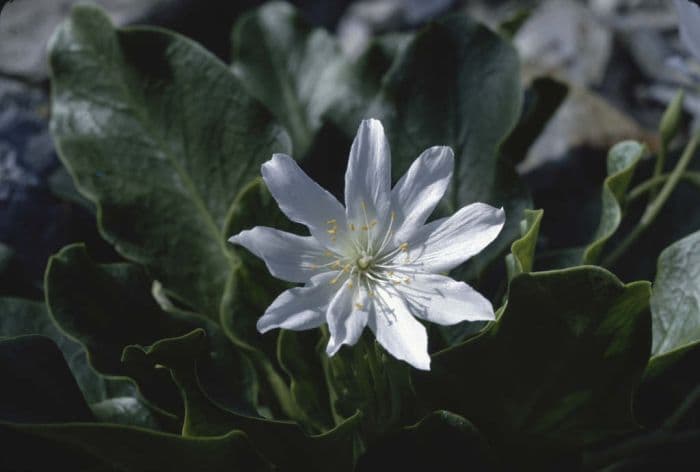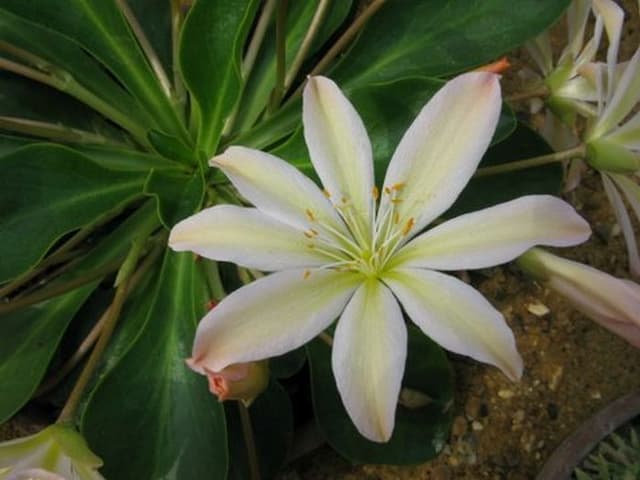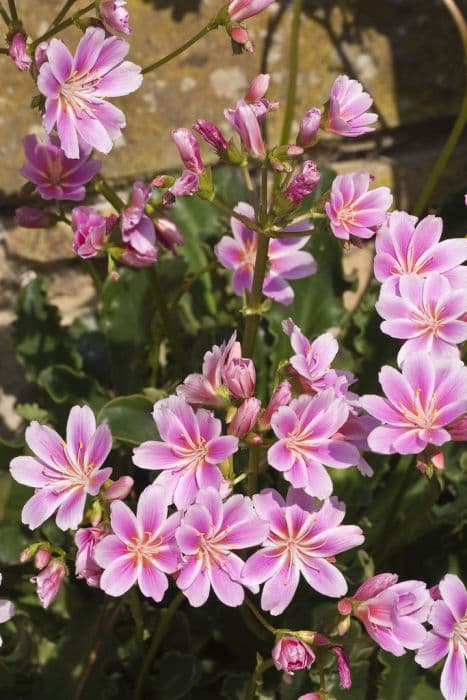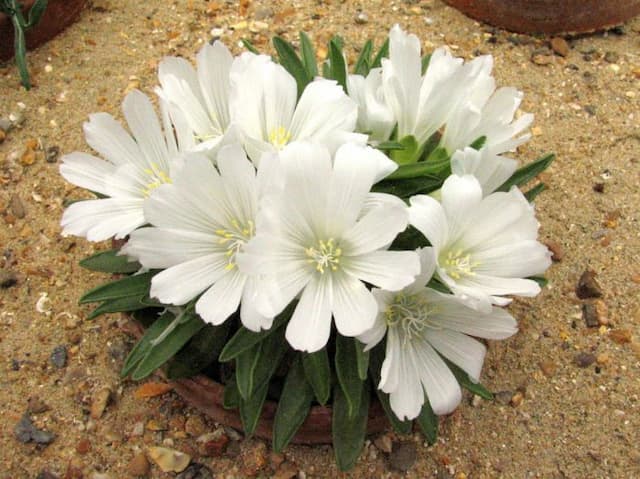Tweedy's Lewisia Lewisiopsis tweedyi 'Alba'

ABOUT
Lewisiopsis tweedyi 'Alba', commonly known as Tweedy's lewisia or simply lewisia, is a perennial plant known for its ornamental value. It possesses a rosette of fleshy, evergreen leaves that are spoon-shaped and can range in color from green to a reddish tone at the edges, providing a lush and attractive base for its flowers. Rising above the foliage in the flowering season, it boasts clusters of beautiful, large white flowers. Each flower is composed of several rounded petals radiating from a central point, creating a daisy-like effect. The blossoms can have a subtle shade of pink or yellow towards the center, adding a gentle contrast to the pure white petals. The visual appeal of lewisia lies in its delicate floral display, which is particularly stunning when the plant is in full bloom, creating a soft and elegant appearance that can brighten rock gardens and alpine settings.
About this plant
 Names
NamesSynonyms
Tweedy's Lewisia, Alba Lewisia, White Lewisia
Common names
Lewisia tweedyi 'Alba', Oreobroma tweedyi 'Alba'.
 Toxicity
ToxicityTo humans
Lewisiopsis tweedyi 'Alba' is commonly known as Tweedy's lewisia. There is limited specific information available about its toxicity to humans, as it is not widely known as a poisonous plant. However, many plants in the family to which it belongs, Portulacaceae, are not considered toxic. If in doubt, it is best to avoid ingestion and contact with any plant material, and consult with a medical professional or poison control center if exposure occurs.
To pets
Tweedy's lewisia, the common name for Lewisiopsis tweedyi 'Alba', does not have a well-documented profile of toxicity to pets. Many plants in the lewisia genus and its wider family, Portulacaceae, are not commonly regarded as dangerous to animals. Nevertheless, to ensure the safety of pets, it is wise to prevent them from consuming plant parts, and consult a veterinarian if any ingestion is suspected.
 Characteristics
CharacteristicsLife cycle
Perennials
Foliage type
Deciduous
Color of leaves
Green
Flower color
White
Height
2 feet 6 inches (76 cm)
Spread
2 feet (61 cm)
Plant type
Herb
Hardiness zones
4
Native area
North America
Benefits
 General Benefits
General Benefits- Ornamental Value: Lewisiopsis tweedyi 'Alba', commonly known as Tweedy's Lewisia, has striking white flowers that add aesthetic beauty to gardens and landscapes.
- Drought Tolerance: This plant is well-adapted to survive in dry conditions, making it suitable for rock gardens and arid landscapes.
- Low Maintenance: Tweedy's Lewisia generally requires minimal care once established, making it a convenient choice for busy gardeners.
- Attracts Pollinators: The vibrant flowers can attract butterflies and bees, promoting pollination in the garden.
- Cold Hardy: It can withstand cold temperatures, making it suitable for planting in various climates.
- Compact Size: Its small stature allows it to be planted in containers, rockeries, or small beds, offering versatility in landscaping.
- Rarity and Uniqueness: This variety is not as common in gardens, providing an element of uniqueness to a collection.
 Medical Properties
Medical PropertiesThis plant is not used for medical purposes.
 Air-purifying Qualities
Air-purifying QualitiesThis plant is not specifically known for air purifying qualities.
 Other Uses
Other Uses- Lewisiopsis tweedyi 'Alba', commonly known as Tweedy's Lewisia, can be used in rock gardens to create stunning visuals due to its resistance to drought and love for well-draining soil.
- The plant's intricate, white flowers make it a beautiful option for botanical illustration and artistry, providing a delicate subject for detailed watercolor paintings or botanical sketches.
- Tweedy's Lewisia is an excellent candidate for xeriscaping, helping to conserve water in landscaping projects that aim to create visually appealing designs with minimal environmental impact.
- Due to its compact growth habit, Tweedy's Lewisia can be utilized in container gardens, often used to adorn balconies or patios where space is limited.
- The bright flowers of the Tweedy's Lewisia can be used in photography, particularly macro photography, to capture the fine details and vibrant colors of the plant's blossoms.
- This plant can be part of educational gardens or school projects focusing on alpine or rock garden ecosystems, helping students understand the specific ecological niches these plants fill.
- In regions where late spring or early summer celebrations occur, the Tweedy's Lewisia, with its seasonally timed blooming, can be incorporated into event decorations such as table centerpieces or venue plantings.
- Its ability to attract pollinators like bees and butterflies enables its use in gardens designed to support and increase local pollinator populations.
- With its hardy nature, Lewisiopsis tweedyi 'Alba' serves as an ideal choice for novice gardeners, providing a visually rewarding experience without the need for intensive care or resources.
- The contrasting white flowers and green foliage make Tweedy's Lewisia a great plant for practicing color contrast in landscape design, teaching principles of visual harmony and composition.
Interesting Facts
 Feng Shui
Feng ShuiThe plant Tweedy's lewisia is not used in Feng Shui practice.
 Zodiac Sign Compitability
Zodiac Sign CompitabilityTweedy's lewisia is not used in astrology practice.
 Plant Symbolism
Plant Symbolism- Rarity - Lewisiopsis tweedyi 'Alba', commonly known as Tweedy's Lewisia or Alba, is a relatively rare plant, symbolizing uniqueness and the value of scarcity.
- Resilience - Native to mountainous regions, this plant is hardy and can survive in tough conditions, representing the ability to endure and thrive despite challenges.
- Beauty - With its delicate, white flowers, the Alba variety of Tweedy's Lewisia is often associated with pure beauty and elegance.
- Adaptability - The species' capacity to adapt to various soil types and environments signifies flexibility and the importance of being versatile.
- Rebirth - As a perennial plant, it symbolizes renewal and the cycle of life, returning each year with fresh growth.
 Water
WaterFor Tweedy's Lewisia, ensure the soil slightly dries out between waterings, especially during its growing season in spring and summer. On average, water the plant once a week, but adjust according to temperature and sunlight exposure, as it may need more frequent watering in hotter conditions. When watering, thoroughly soak the soil until water runs out of the drainage holes, using around one quart for smaller pots or up to 2 gallons for larger containers depending on the pot size and soil volume.
 Light
LightTweedy's Lewisia thrives best in bright, indirect light or partial shade. Place the plant in a spot where it can enjoy some morning sun followed by dappled shade in the afternoon to mimic its native alpine habitat. Avoid prolonged exposure to intense midday sun, which can scorch its leaves.
 Temperature
TemperatureTweedy's Lewisia prefers cooler temperatures, thriving in a range from 40°F to 75°F. It can withstand temperatures down to about 30°F but should be protected from frost. Ensure that it is not exposed to temperatures above 80°F for prolonged periods, as excessive heat can stress the plant.
 Pruning
PruningPruning Tweedy's Lewisia is most beneficial after it has flowered, to remove spent blooms and encourage a tidy growth habit. Prune lightly, just enough to remove dead or faded flower stalks. This task is typically done annually, in late summer or early fall after the blooming period has ended.
 Cleaning
CleaningAs needed
 Soil
SoilFor Tweedy's Lewisia (Lewisiopsis tweedyi 'Alba'), a well-draining soil mix, similar to a cactus mix, is ideal. It should be a gritty, porous composition with pebbles or perlite to facilitate drainage. The best soil pH for Lewisiopsis tweedyi 'Alba' is slightly acidic to neutral, ranging from 6.0 to 7.0.
 Repotting
RepottingTweedy's Lewisia should be repotted every 2-3 years or when it outgrows its current container. Use a well-draining soil mix and ensure the pot has sufficient drainage holes. This species does not like to be disturbed too much, so repotting is typically only done when necessary.
 Humidity & Misting
Humidity & MistingTweedy's Lewisia prefers moderate humidity levels, as too high humidity can promote fungal issues and rot. Aim for a humidity level between 40-50% for optimal growth conditions for this plant.
 Suitable locations
Suitable locationsIndoor
Place in bright, indirect light and ensure good air circulation.
Outdoor
Plant in alpine gardens or pots with morning sun, evening shade.
Hardiness zone
4-8 USDA
 Life cycle
Life cycleLewisiopsis tweedyi 'Alba', commonly known as Tweedy's lewisia, begins its life as a seed, often requiring stratification or a period of cold to break dormancy. Upon germination in spring, it develops a rosette of fleshy, evergreen leaves from which emerges a flowering stalk. The stalk bears delicate white flowers that are pollinated by insects, leading to the production of seeds. After flowering, the plant enters a period of dormancy during the hot summer months. It resumes growth with cooler, moist conditions in fall or remains dormant until the next spring. The perennial nature of Tweedy's lewisia allows it to repeat this cycle for several years, with older plants often forming offsets to propagate asexually.
 Propogation
PropogationPropogation time
Spring-Early Summer
Propogation: Tweedy's Lewisia, or Lewisiopsis tweedyi 'Alba', is a perennial plant that can be propagated most effectively by division. The best time for propagation is in the spring after the plant has finished flowering, or in the fall when the plant is dormant. To propagate by division, carefully dig up the plant, making sure to keep a generous amount of soil around the roots. Gently separate the plant into smaller sections, ensuring that each section has a portion of the root system. Replant the divisions promptly at the same soil depth they were growing at previously, and water them thoroughly to help establish the new plants. This low-maintenance method is favored for its simplicity and effectiveness in producing exact clones of the parent plant.




